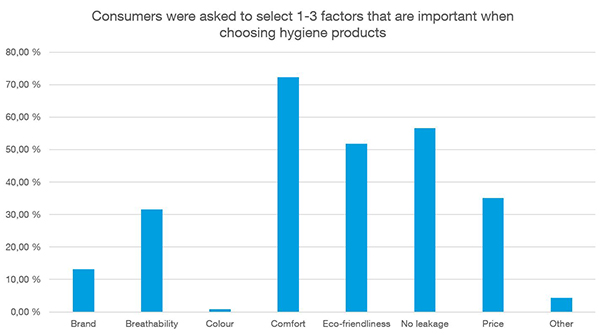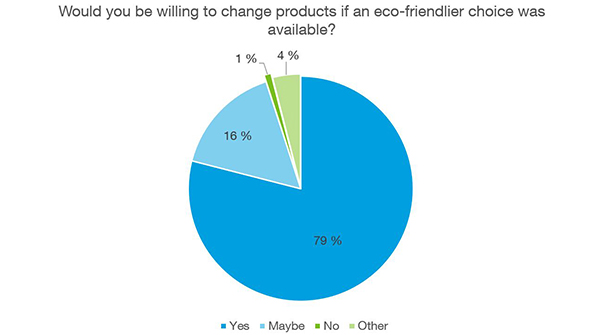We conducted a survey to find out consumers’ opinions towards eco-friendly hygiene products and if the colour of the product plays a role in their decision making.
Product features that stand out
According to our survey, the most important factors in choosing hygiene products are comfort, eco-friendliness and no leakage.
“I would love to find products that are high quality but eco-friendly.”
“While I don't have a need for baby diapers anymore, I have always been very aware of their environmental impact.
Anything we throw away or flush out needs to be eco-friendly.”

Consumers willing to change products for an eco-friendlier option
Surveys have shown that people believe that their personal actions, such as buying ethically, can make a real difference in the world. Furthermore, they expect brands to help them achieve a more environmentally-friendly daily life.
“We use so many hygiene products, so it is very important to use the most eco-friendly version.”
We came to the same conclusion. 79 percent of respondents said they would be willing to change products if eco-friendlier option were available and 16 percent said they might be willing to change. Only one percent answered that they would not be ready to switch to an eco-friendlier option.
“My child no longer uses baby diapers, but I was surprised when she was a baby (7-8 years ago)
that all diapers were white. I would definitely be willing to buy less bleached options.”

Consumers do not expect white hygiene products any longer
Brown and beige colours are firmly linked in consumers’ minds to an eco-friendly product. Some of the respondents voiced their opinion about white colour in hygiene products representing unnecessary processes and more chemicals.
“In general, beige represents environmental aspects nowadays
and ultra-white often represents unnecessary processes.”
When we asked if consumers have any doubts or negative feelings towards less white hygiene products, only five percent said they did.
“At first, it might feel strange, but when a clarification is trustworthy, why not.”
Does price matter?
A pre-pandemic study conducted by Nielsen showed that consumers are willing to pay extra for sustainable products and that the trend is rising. This is especially true with millennials. Almost three out of four respondents were willing to spend extra for sustainable offerings.
We came to the same conclusion. According to our survey, 86 percent would or might be ready to pay more for eco-friendly products. Only 14 percent thought that the price was more important.
“Most important is that the product works: no leakage. If that is the case,
I would pay more for an environmentally friendly product.”
Some respondents wanted to clarify that they are willing to pay more but there is a limit to how much more an eco-friendly product can cost.
“As long as the products are of the same quality as the non-eco ones,
I'm prepared to pay more for them. But not more than, let’s say, 20% more.”
It is important to have multiple options to choose from
Many people would be willing to use disposable hygiene products as they are so convenient, however, some of the respondents explained that they had already switched to menstrual cups or cloth diapers as these were the only eco-friendly options they could find from stores.
“I think that when it comes to pads and tampons, biodegradable menstrual cups are a strong competitor.
They're the reason I stopped using pads, but if there were a more eco-friendly option on the market,
I might still buy pads now and then.”
For some respondents, trying out completely new types of products can be intimidating. Therefore, it is important to have multiple options of eco-friendly products available to consumers.
“I know that the ‘menskopp’ (menstrual cup) is more eco-friendly
but I haven't gotten around to trying it because it's such a new concept.
So I'd love a more eco-friendly option that doesn't require me to try a new concept.”






